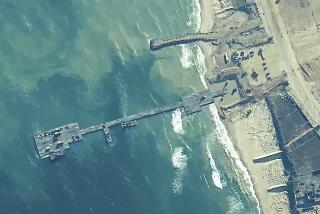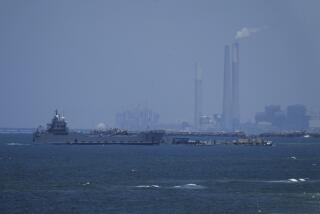Moving Out, in a Big Way : Military: The staggering logistics of transporting and equipping the Somalia mercy mission include taking along virtually everything needed.
- Share via
Huge helicopters were being taken apart with cranes and forklifts at the El Toro Marine Corps Air Station on Tuesday to be airlifted by the U.S. military’s largest cargo jets to Somalia.
Once there, these CH-53E Super Stallions, the workhorses that will transport troops to strategic locations in the strife-torn African country, will be put back together.
That alone will take 12 to 16 hours for each aircraft. And there are 22 of them.
Getting helicopters to Somalia is just one of many logistic challenges facing the military in preparing camp for 28,000 members of the Army, Navy, Air Force and Marines in that remote land.
“We basically have to build a city for ourselves,” noted Lt. Col. Carter Hutson, who was busy at Operation Restore Hope’s nerve center at Camp Pendleton Tuesday helping to coordinate supplies--from water to fuel and equipment--to sustain and support the troops charged with assisting charitable agencies deliver food to starving Somalis.
Hutson, who is part of the joint military task force, said that in many ways the logistics of the Somali operation are more difficult than those for Desert Storm. He said that Saudi Arabia, unlike Somalia, had a modern port, some basic sanitation facilities and a friendly government.
“Essentially what we bring is what we will have,” said Hutson. He said that everything the troops will need will have to be brought by ship or plane to the remote East African country.
After the infantry secures the area, he said, the Seabees, the Navy’s construction crews, will improve the main airstrip, adding lighting and taxiways and apron spaces to accommodate larger numbers of cargo-bearing planes and enable night landings.
It will take weeks, military officials stress, before everything--from latrines to water purification equipment, hard-floor tents, communications stations, electrical generators, telephone lines and field kitchens--can be set up.
During the first 10 to 15 days, Hutson said, the troops will not have enough water to shower and will have to use field latrines.
Navy Lt. Cameron Manning, the Seabees’ liaison for Operation Restore Hope, said about 1,600 Seabees ultimately will fly to Somalia from bases throughout the United States.
He said that initially they will need about $1.6 million worth of construction materials, from concrete to lumber, nails and plywood, that will be shipped from the United States and another $1 million in building supplies to be purchased from neighboring countries.
Manning said he believes that a major problem will be making the local roads passable for the food convoys. “I have heard the roads described as potholes surrounded by patches of asphalt,” he said. Marine forces also will have to clear the roads of mines, Hutson said.
In sustaining the troops, Hutson said, the most important task will be providing potable water, which is not available in Somalia. When the operation is up and running, he said, there will be a requirement of 20 gallons of water per day per person.
Chief Warrant Officer Bradley Patch said that at first the camp will be dependent on fresh water that is flown or shipped in, but an increasing amount of the water supply will be provided by purifying well water and ocean water through reverse osmosis.
Military planners say that much of the supplies and equipment that the troops will need is already aboard ships in the Indian Ocean that are positioned to respond to a military emergency.
“There is already one waiting off the African coast, and there will be three more pulling in within the next few days,” Hutson said. The ships are from a naval base at the island of Diego Garcia in the Indian Ocean.
These ships, Hutson said, are specially designed to carry trucks and tractor-like vehicles. They will deliver some of about 45 light-armored vehicles mounted with machine guns that will be used as an escort for the food convoys to Somali villages. The rest will be airlifted in, he said.
Patch said the troops also will rely on Navy ships to provide the camp with jet fuel and gasoline, which will be consumed at a rate of about 300,000 gallons a day. “There should be enough on pre-apositioned ships in the Indian Ocean for the whole operation,” Patch said. The fuel is costing the military about $1 a gallon, he added.
Another major concern, Hutson said, is to attend to the medical needs of troops entering a country where they will be exposed to such serious diseases as malaria, cholera, hepatitis and yellow fever. “We are flying in a large medical contingent, and we will eventually have a fleet hospital in the area,” he said.
While delivering food to Somalia’s famished people is the goal of the mission, the military also has to worry about feeding its own.
Maj. Nick Shrum, the joint task force food service officer, said feeding the American troops is expected to cost $15 million a month.
He said each of the troops from Camp Pendleton will be carrying along a two-day supply of food in his or her pack. This food consists of “Meals, Ready to Eat,” or MREs.
Another five-day supply of MREs will accompany the troops in their planes, and the supply ships supporting the mission will have enough food to feed 16,500 troops on MREs for 30 days. More supplies will have to be shipped in to accommodate the rest, Shrum added.
Hutson said the MREs have been improved since Desert Storm and described their taste as “not bad.” Nonetheless, he said, the goal is to get the troops off MREs within 10 days. “Field kitchens will be set up as soon as possible,” he said.
“We are hoping to produce a hot turkey Christmas meal with all the trimmings, including cranberry sauce, candy and nuts,” said Shrum.
Helicopters That Will Help The 3rd Marine Aircraft Wing and its units at the El Toro Marine Corps Air Station, Tustin Marine Corps Air Station and Camp Pendleton are expected to send about 2,000 troops to Somalia. Cutting the highest profile will be the various helicopters that are used in a variety of chores. A look at the three from Orange County doing duty in Africa:
CH-53E Super Stallion: This heavy-lift helicopter, the largest and most powerful outside the former Soviet Union, is used to carry trucks, light-armored vehicles and other heavy loads from position to position. It is one of the few helicopters with a load capacity that exceeds its weight. It entered operational service in the Mediterranean area in 1983. About 20 are going to Somalia from Tustin. Maximum speed: 196 m.p.h. Range: 1,290 miles Crew: 3 and 55 troops Capacity: 36,000 pounds Overall length (fuselage): 73 feet, 4 inches
AH-1J Sea Cobra: The Cobra provides close air support for amphibious landings and ground maneuvers. The pilot and gunner control a 20 millimeter gun and a variety of rockets, including the laser-guided Hellfire missile. About a dozen Cobras are bound for Somalia from Tustin. Maximum speed: 219 m.p.h. Range: 395 miles Crew: 2 Overall length (fuselage): 45 feet, 6 inches
UH-1N Iroquois: One of the most durable and versatile utility helicopters ever built--the distinctive “whop” of its rotor blades is often associated with Vietnam--the Iroquois is used for moving troops, light equipment and for medical evacuations. It can carry 11 to 14 combat-equipped Marines or six injured passengers with one attendant. About dozen are going to Somalia from Tustin. UH-1N Iroquois Maximum speed: 115 m.p.h. Range: 261 miles Crew: 1 and 11-14 troops, or 6 litters and a medical attendant Overall length (fuselage): 42 feet, 4 inches Source: Jane’s All the World’s Aircraft, 1990-91
More to Read
Sign up for Essential California
The most important California stories and recommendations in your inbox every morning.
You may occasionally receive promotional content from the Los Angeles Times.










